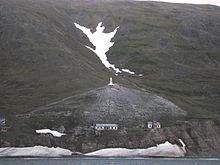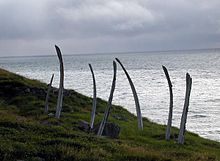Naukan
The Naukan or Nyvukagmit are a Yupik- speaking Eskimo people on the eastern Chukchi Peninsula in the Russian Chukchi Autonomous Okrug (Chukotka). They lived in Naukan near the easternmost point of Asia at Cape Deschnjow and had relatives on Big Diomede Island in the Bering Strait . They have been scattered since the 1950s and now mostly live in Lorino .
history
As genetic studies have shown, the Naukan are an ethnic group whose ancestors go back to migrating back from Alaska. The small community lived from hunting marine mammals; Every year there was a great whale festival, the month-long Pol'a . Ritually played walruses and seals a much smaller role.

According to archaeological research, the village of Naukan can be traced back at least 2000 years. It was created on a beach surrounded by high mountains on three sides. According to tradition, the residents built a kind of refuge above the wind-protected village, into which they could withdraw in the event of danger from the sea.
There were nine clans in the village, six of which were considered to be originally resident there and whose reputation was higher than that of the other three. While the hunting areas were not tied to clans, it was the districts and the places where meat was dried on scaffolding. Marriage within a clan was strictly forbidden. Until the early 20th century, each clan was subordinate to an elder who coordinated ceremonies and hunting. So he opened the hunting season and set the timing of the Chukchi visits. In cooperation with the other clan elders, he had the task of settling disputes. His position was hereditary and usually passed on to the son, as the lineages were altogether patrilinear . The clan leader of the most powerful clan ran the village.
The Alaskan neighbors, who lived on the Cape of Prince of Whales , 89 km away , visited the village regularly. During the Pol'a, but also at other gatherings, sporting competitions were held, dances and rituals performed. The dancers from Naukan were considered the best. Memories of attacks from Asia can be found on the Seward Peninsula , while the Naukan have lost any memory of these attacks in the 18th and early 19th centuries. While products from the reindeer nomads were exchanged and given away from the west, Alaskan fishermen came from the east. In peacetime the Naukan brought ivory , fox skins and boots to Alaska, while from there mainly European goods, i.e. weapons, chewing tobacco, European clothing and tools came. A visit was, however, necessarily linked to the fact that the visitor already had relatives on the other side of the Bering Sea.
A more intensive contact with the Russian language did not begin until the 1920s, while English influence, probably mediated by American whalers, was noticeable earlier. Parts of the clan system were maintained until the 1950s. This included separate cemeteries for each clan. The Naukan still insisted in the 1960s that marriage should never take place within the clans.
The village of Lorino was founded in 1933 in place of an older Chukchi settlement as the center of the Rajon founded in 1927 and as a "cultural base" as part of the collectivization of reindeer herding . In 1953, the Soviet government began to force the small ethnic groups together. The small village of Lorino became a collective farm ( kolkhoz ) dedicated to Lenin , in which sedentary Chukchi from the coast and nomadic reindeer Shukchi, as well as the Yupik from the area, including many from Naukan, had to live. There was heavily subsidized reindeer herding. In 1958, the Soviet government declared the town of Naukan to be an unpromising village and had the inhabitants brought to the settlement near Kolkhoz Nunjamo (near Lavrentija , on the opposite bank of Lavrentija Bay, about 60 km southwest of Naukan; location ), which in turn closed in 1977 has been. The perhaps 70 Yupik speakers from Naukan went to the Chukchi settlement of Uelen. In the 1990s, government subsidies ceased and civil servants were withdrawn. As the local fox farms were fed hunting the local marine life, the fish and mammal populations had declined sharply; In addition, it was not possible to supply an artificial settlement with around 1500 inhabitants, as represented by Lorino, with sufficient supplies from these stocks.
One of the most important poets of the village is Soja Nikolaevna Nenlyumkina. She was born in Naukan in 1950 and studied at the Anadyr Teachers College. She read on Radio Chukotka in her mother tongue . In 1979 she published her first collection of poems in Russian and Yupik in Magadan under the title Ptizy Naukana ("The Birds of Naukan"). Tasjan Michailowitsch Tein, who was born there in 1938, also comes from Naukan. He was a teacher and wrote children's songs and books.
literature
- Elizaveta Alikhanovna Dobrieva, Steven A. Jacobson (Eds.): Naukan Yupik Eskimo Dictionary , Alaska Native Language Center 2004.
Web links
- Ludmila Ainana , Tatiana Achirgina-Arsiak, Tasian Tein: Northeastern Siberian. Yupik (Asiatic Eskimo) , Alaska Native Collection, Smithsonian Institution
Remarks
- ↑ David Reich, Nick Patterson et al .: Reconstructing Native American population history , Nature 2012, online publication: July 11, 2012, doi: 10.1038 / nature11258
- ^ Jean-Paul Labourdette, Dominique Auzias: Chukotka , Moscow 2006, p. 118.
- ↑ Alexia Bloch, Laurel Kendall: The Museum at the End of the World. Encounters in the Russian Far East , University of Pennsylvania Press 2004, pp. 86f.
- ↑ James Oliver: The Bering Strait. Project Symposium , Information Architects 2004, p. 57f.
- ^ William C. Sturtevant: Handbook of North American Indians , Vol. 5: Arctic, 1984, p. 255.
- ^ Thomas S. Litwin: The Harriman Alaska Expedition Retraced: A Century of Change, 1899-2001 , Rutgers University Press 2005, p. 225.
- ^ William C. Sturtevant: Handbook of North American Indians , Vol. 5: Arctic, 1984, p. 248.
- ↑ Nina Nadjarnych: Literatura narodov Rossii. Moscow, Nauka 2005. p. 255
- ^ Valerie Alia: The New Media Nation: Indigenous Peoples and Global Communication , Berghahn Books 2013, p. 42.






